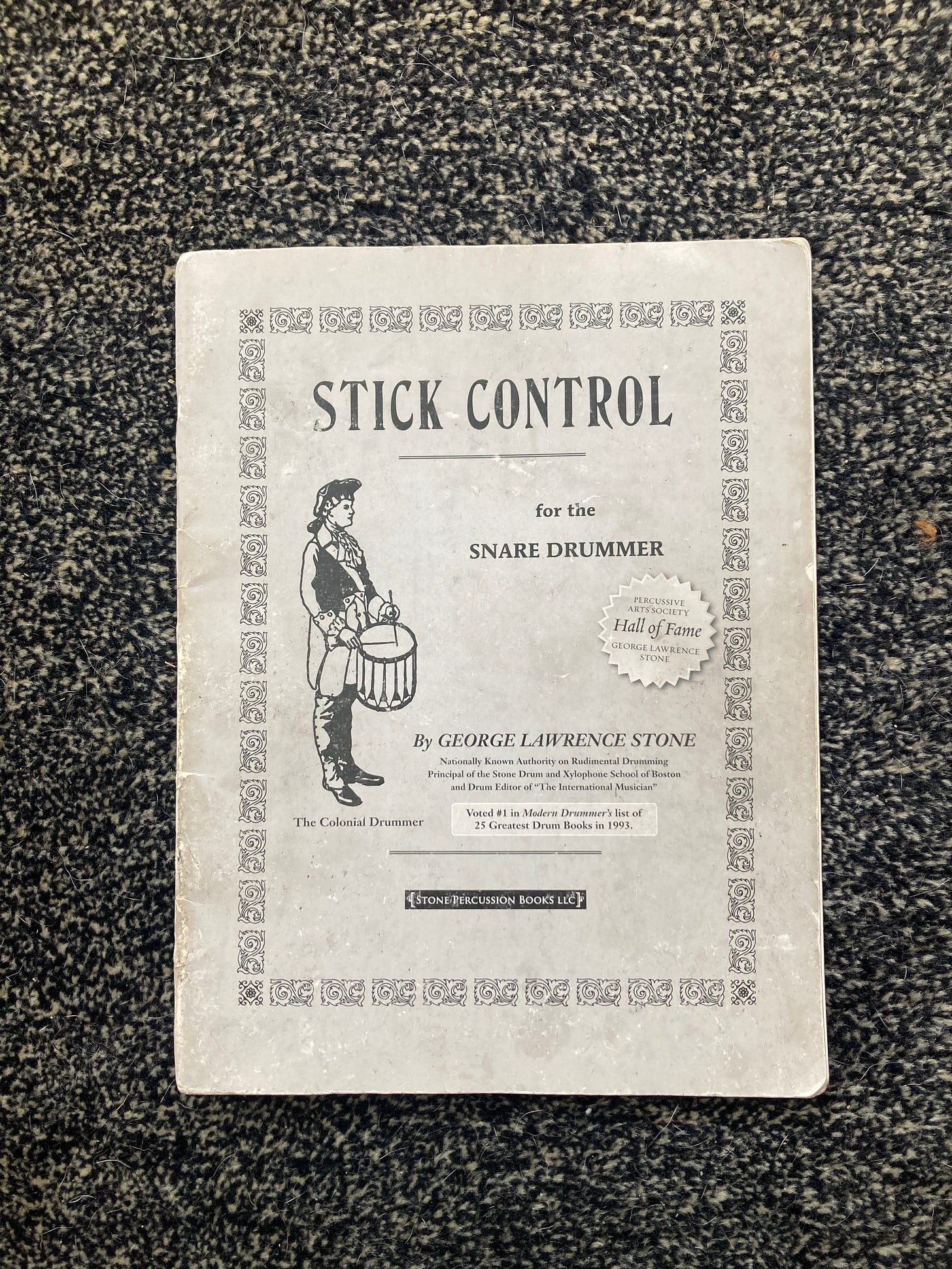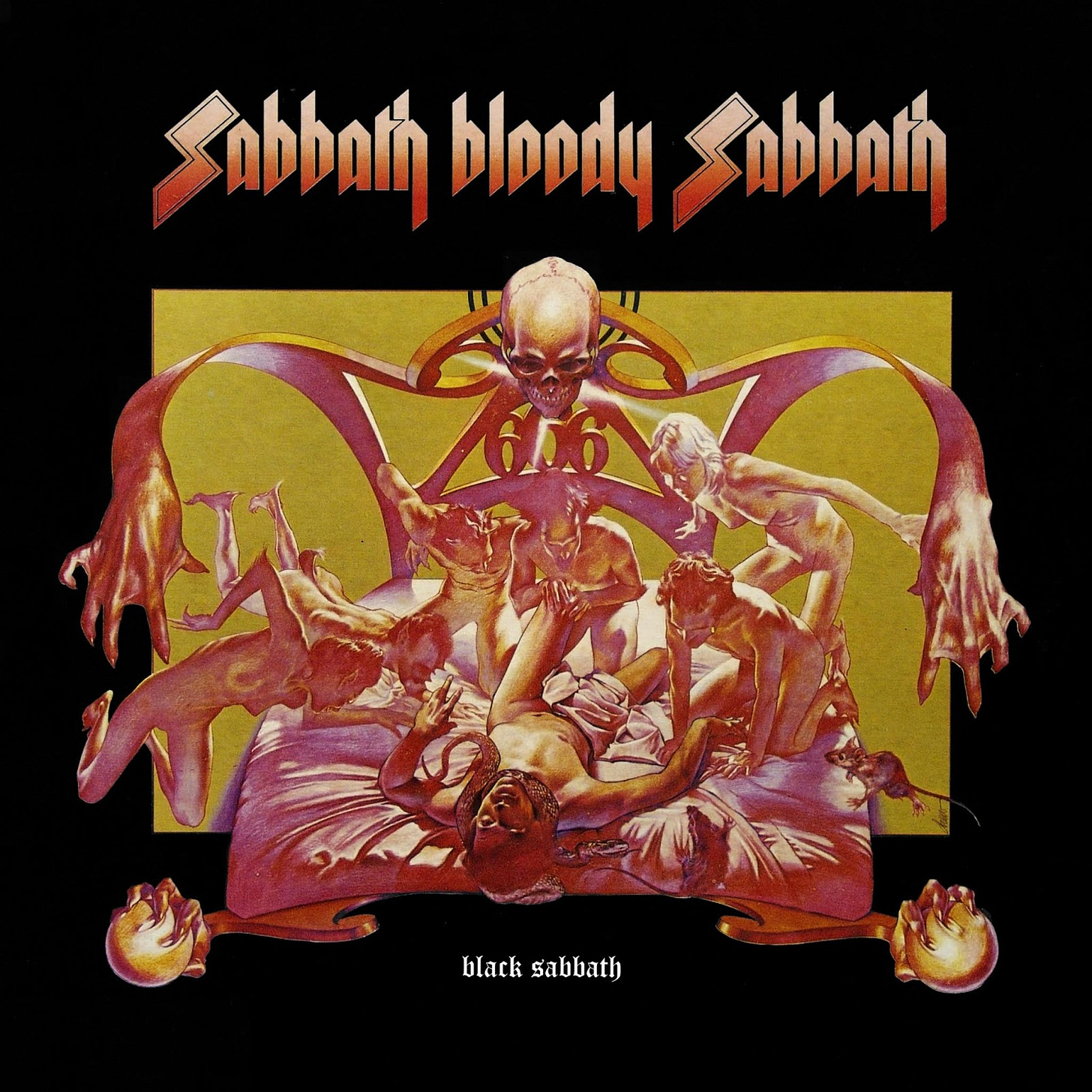The Joy of Stick Control
Why a century old drum instructional book isn't that different from a video game
Last week I wrote about the one year anniversary of my album The Lonely Atom. Last year as I was gearing up to release the record I was also eagerly awaiting word about a drum teaching gig. The good news eventually arrived, and since June I’ve found steady employment teaching drums to children and adults in New York City and Chicago, IL. Shortly after landing the job I dusted off my old collection of drumming instructional books to bring with me to my lessons. Not only did I want to have a reference on hand with pre-written sheet music (in much more legible type than my whiteboard handwriting), I also wanted to get back in the headspace of my own student days. I want to make sure that my own fundamentals are solid before I start offering advice to drummers with less experience. Plus, because I’m a freak and a weirdo, I find working out of drumming books fun. If I arrived to the studio early or had time between lessons, I’d crack open the trio of books in my on-the-go collection and work through a page or two to kill time. Eventually I got so into the habit that I began my personal non-teaching sessions by working through the books before working on Drumming Upstream covers or session work.
Until last week I’d start each of these sessions by cracking open Stick Control For The Snare Drummer by George Lawrence Stone. I say “until last week” because after months of inching through the book one page at a time I finally reached the end of Stick Control. This means that a 46 page book took me about as long to finish as War & Peace. Obviously the two require vastly different kind of reading to get through, but I think the comparison at least gives us a baseline for how much work it takes to “complete” a drum book.
This was not my first crack at Stick Control. I was first assigned the book by my college drum teacher Tom Hipskind1, who’d have me work through a handful of exercises at the start of each lesson. After I graduated I kept working on the book privately but got stuck somewhere around page 20 and put it back on the shelf. My copy still has visible notes in pencil from that first attempt at completing it, with the exercises that gave me the most trouble circled and underlined. Some of those exercises still kicked my ass a decade later. Others were surprisingly easy. I suspect that I spent so much time struggling with those trouble exercises that they sunk deeper into my subconscious and thus were easier to bust out on command the second time around. But I’m getting ahead of myself, let me first break down what Stick Control is before talking about what it does.
Stick Control For The Snare Drummer is a 90 year old instruction manual written, as the title and cover suggests, for orchestra and marching drummers. A typical page contains 24 two measure exercises meant to gradually introduce a drummer to just about every combination of sticking patterns that they’ll likely encounter in any professional situation. The practicality of these exercises range from “absolutely essential” to “hey, you never know” to “you better be paid a lot if they’re asking you to do this”. The exercises are thoroughly arranged, methodically working through their variations with no regard to the drummer’s dominant hand. Anything that you are asked to play leading with your right you will also have to perform leading with your left. Taken on their own the drills are almost shockingly un-musical. No dynamics, no syncopation, and only the suggestion of phrasing. If played on the snare drum as written Stick Control recalls industrial machinery in its dull repetition. Somewhat paradoxically, the purpose of Stick Control lies not in the sound it produces but in how it makes you feel as you play it. First frustration. Then, a stalemate. A moment of focus, a breakthrough and then a steady flow that gives way, if you are persistent enough, to something approaching pleasure.
This cycle should be familiar to not just the musicians reading, but my fellow video game enthusiasts. Stone instructs that each exercise be repeated 20 times. If you take that to mean 20 perfect repetitions, this leaves plenty of time for your mind to wander. As the overtones of a snare drum played steadily in a closed room accumulated around me, my mind would often wander to video games. I’d recall Metal Gear Solid and it’s training mode, stylized as a virtual reality simulator for your in game avatar. Something about the spartan simplicity of the alternation between R for right hand and L for left hand reminded me of the polygon minimalism of those optional tutorials, as well as their iterative progression. It wouldn’t be the only time my mind wandered to video games as I worked through Stick Control. You don’t have to read too far to see the faintest hint of game design lurking between all of those 8th notes, Ls and Rs. Just as with iconic opening levels like Super Mario’s 1-1 or Doom’s E1M1, page 1 of Stick Control prepares the intrepid drummer for everything that will follow. Nearly every exercise in the book boils down to a variation on the single strokes (RLRL), doubles (RRLL), paradiddles (RLRR LRLL) and inverted doubles (RLLR) that make up the bulk of the first page. By the end of the book each of these short building blocks serve as footholds on the increasingly rocky terrain that Stone expects you to dutifully navigate 20 times in a row.
The terrain does change over time. Stick Control is broken into sections that focus on particular skills. There are the pages centered on rolls, on triplets, on measures of 6/8 and measures of 3/8. Each section has its own flavor and “hand feel”. By the end of each section you feel like you’ve come to understand its “character” on a cognitive level. Some of these characters… are jerks! When I’ve spoken to other drummers who’ve played through Stick Control all of them have brought up the dreaded page 16, the opening of the section focused on flams, in the same tone that veteran Souls players talk about Blight Town. Even these commiserations however are tinged with a meta-textual kind of fun. Knowing that other drummers have bashed their heads against the wall trying to parse the difference between nearly identical flam drills builds a sense of camaraderie with the rest of the instrumental community.
Plenty of great drummers have endured Stone’s rite of passage. My copy of the book has blurbs from some of my favorites (Jojo Mayer! Thomas Lang! Billy Cobham!) alongside other revered drum instructors (Jim Chapin! Joe Morello!) and wildly successful musicians like Chad Smith, Kenny Arnoff, and Steve Gadd. One thing you’ll quickly notice about the testimonials is that the majority of them come from kit drummers, not drumline or orchestra percussionists. What these endorsements reveal is a truth familiar to many video game fanatics: with enough creativity you can play the “game” however you want. In the same way that speed runners upend the expectations and stated strictures of a video game, a creative drummer can bend the rigid exercises of Stick Control into all sorts of new shapes. Once you master a drill with your hands try playing it with your feet instead, or pit your right side of your body against your left by playing it with your hands and feet simultaneously. Or, try playing one exercise with your hands and another one with your feet. Heck, read the whole book again while playing it over a samba foot pattern. The possibilities are literally endless.
Personally I don’t expect to give Stick Control another go for at least a few years. Those last few pages were a real doozy and I have other equally edifying books to work through. But I’m certain that I will return to it eventually and that when I do I’ll find a new way to draw out new ideas even from the oldest and crustiest of material it offers me.
~ ~ ~ ~ ~ Listening Diary ~ ~ ~ ~ ~
“Motivated Reasoning” by Exorbitant Prices Must Diminish (For A Limited Time, 2024)
Last week I ended with a very long song recommended from Calder Hannan’s Best Albums of 2024 list. This week I’d like to start with a very short song I came across from the same list. I have a soft spot for clean, precise European grindcore. I love those clean cuts to just bass and then the sprint into triplets at the end of the song. Like the Father John Misty song I shared earlier in the year (bet this band never thought they’d earn *that* comparison) this track pokes at the underlying tension between making art and filling the world with plastic junk.
“Crash” by Isaiah Collier (The World is On Fire, 2024)
I wonder if Michael Shekwoaga Ode has worked through Stick Control. Well, whatever Ode’s doing it’s working. This whole track is great if you’re into Coltrane-style spritiual jazz, but it really takes off when the rest of the band clears out to let Collier and Ode go toe-to-toe for a hair raising double solo. I’m usually a little hesitant to ascribe heavy metal comparisons to intense jazz drumming, but there’s some stuff near the end of this track that gets pretty damn close to blasting.
“Kilimandjaro My Home” by Eko (Kilimandjaro My Home, 1976)
Shouts out to Wolf’s Week for the disco list. As a drummer I wouldn’t think of this as a disco beat, not enough four-on-the-floor, but the rest of the arrangement sells it. Groovy bassline, big string section, understated rhythm guitar, horn stabs, etc. Drummer really goes off in the second half of the song.
“Eggshell” by Autechre (Incunabula, 1993)
I think I’ve been taking the wrong tack with Autechre. Instead of bouncing around their discography searching for the album that will make me understand their impenetrable style like a stroke of lightning, maybe I should just… listen to the albums I’ve already heard again. Seems obvious, but sometimes I am quite dumb! The truth behind every “IDM” (hate that term, but you know what I mean) act is that if you scroll far enough back in their catalog you will find straight up dance floor friendly HEATERS. That descending bell melody in the second half is so good.
“Temporal Disintegration” by Defeated Sanity (Chronicles of Lunacy, 2024)
Near the end of Stick Control the book asks you to quickly alternate between different note values, jumping between 8ths, triplets, and far less common divisions of time like quintuplets and septuplets. Defeated Sanity get up to some similar tricks on this track. “Temporal Disintegration” does what it says on the tin, stretching the meter and tempo of the song into all kinds of ugly new shapes as the band move from one riff to the next. A perfect blend between death metal’s caveman brutality and its intellectual aspirations.
\ \ \ \ \ Micro Reviews / / / / /
Here are five micro reviews of albums from my vast Rate Your Music catalog. Long time Lamniformes Instagram followers will recognize these from my stories, however they’ve been re-edited and spruced up with links so that you can actually hear the music instead of just taking my word for it.
A Diamond For Disease by Arsis (2006) - Death Metal
The last release before Arsis’s free-fall from the golden boys of American melodic death metal to a nonentity in the scene. Times change quickly, and hype fades fast. Here though the hype was warranted. This EP is all about the title track, a 13-minute long piece originally commissioned for a ballet. Arsis committed to the high culture bit and turned in a no joke, to the tee sonata. In lesser hands that would be a recipe for absolute catastrophe, but Arsis rose to the occasion with the best material they’d ever write. An actual death metal sonata that’s also catchy and fun to listen to, what a concept! The other two tracks are more icing than cake, but I like the band’s “duality of man” approach of putting a raunchy Alice Cooper cover next to their best approximation of the nebulous achievement of high art.
In the Court of the Crimson King by King Crimson (1969) - Progressive Rock
Don’t let the Munch-esque cover and barn burner of an opener fool you, despite its rep as *the* big prog rock album King Crimson’s debut is a remarkably laid back affair, built more on acoustic guitar and lush mellotron than any of the gnarly sounds they’d explore later. Even the extended improv section in “Moonchild”, a stretch that I used to find interminable as a teen, is pretty tame as far as free improvisation goes. What I’m saying is, don’t be intimidated, this album is nowhere near as challenging to the attention span as the band’s imitators.
Red by King Crimson (1974) - Progressive Rock
Now this is the King Crimson record you should be intimidated by. Look at Robert Fripp’s eyes. That’s the look of a man who knows that he wrote “Starless” and you didn’t. My personal pick for the hardest KC album, even the soft tune has some serious bite. Buford’s drumming plays a big role in this record’s mean streak, as does the distorted bass tone. If they had well and truly called it quits here instead of reformulating as a new wave band in the 80s, this record would have served as an appropriate capstone to their career, if not for the whole 70s prog sound. Who could possibly top “Starless”? That song is about as perfect as music gets, start to finish soup to nuts. No better payoff in prog. Masterpiece.
Sabbath Bloody Sabbath by Black Sabbath (1973) - Heavy Metal
For my money, the best of the Ozzy era. Significantly more polished than their first four albums, but still heavy as hell when it wants to be. What makes this record special is how Sabbath frame that heaviness. Sudden intrusions of acoustic sunshine pop, majestic string sections, layers of aux percussion, sci-fi synths, bluesy piano comping… the list goes on. A model of heavy metal eclecticism that I wish more bands would emulate. Side A is perfect. Side B is weird, but even at its worst (“Who Are You?”) it never dips below inspired.
Close to the Edge by Yes (1972) - Progressive Rock
The most important lesson other bands can learn from my personal favorite Yes album is that if your songs are long, keep your record short. Three massive tunes, including a title track that might Yes’s best “epic”. Daunting if you’re scared of big numbers, but surprisingly digestible once it hits the turntable. Even at these extended lengths Yes never lose their tunefulness. Stacks of vocal harmonies shimmering over long counter melodies that jump from instrument to instrument. That green cover is perfect, the album is a veritable forest of music, overflowing with life and sound. That all sounds pretty heady, but once again Bill Buford keeps things grounded by digging deep into his drums. A classic of prog rock’s prettier side.
I’m developing a theory that drum teachers that are really into Rush are also by and large really into Stick Control. My first drum teacher, Peter Davenport, is a certified Rush hater and never assigned me anything out of Stick Control.









